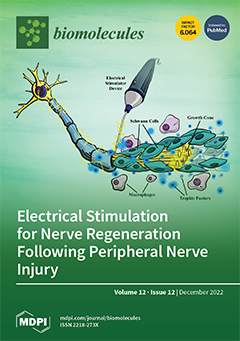Novel constructed bioactive mixed-ligand complexes (
1b) [Cu
II(L)
2(phen)] and (
2b) [Zn
II(L)
2(phen)] {where, L = 2-(4-morpholinobenzylideneamino)phenol), phen = 1,10-phenanthroline} have been structurally analysed by various analytical and spectroscopic techniques, including, magnetic moments, thermogravimetric
[...] Read more.
Novel constructed bioactive mixed-ligand complexes (
1b) [Cu
II(L)
2(phen)] and (
2b) [Zn
II(L)
2(phen)] {where, L = 2-(4-morpholinobenzylideneamino)phenol), phen = 1,10-phenanthroline} have been structurally analysed by various analytical and spectroscopic techniques, including, magnetic moments, thermogravimetric analysis, and X-ray crystallography. Various analytical and spectral measurements assigned showed that all complexes appear to have an octahedral geometry. Agar gel electrophoresis’s output demonstrated that the Cu(II) complex (
1b) had efficient deoxyribonucleic cleavage and complex (
2b) demonstrated the partial cleavage accomplished with an oxidation agent, which generates spreadable OH
● through the Fenton type mechanism. The DNA binding constants observed from viscosity, UV–Vis spectral, fluorometric, and electrochemical titrations were in the following sequence: (
1b) > (
2b) > (
HL), which suggests that the complexes (
1b–
2b) might intercalate DNA, a possibility that is supported by the biothermodynamic measurements. In addition, the observed binding constant results of BSA by electronic absorption and fluorometric titrations indicate that complex (
1b) revealed the best binding efficacy as compared to complex (
2b) and free ligand. Interestingly, all compounds are found to interact with BSA through a static approach, as further attested by FRET detection. The DFT and molecular docking calculations were also performed to realize the electronic structure, reactivity, and binding capability of all test samples with CT-DNA, BSA, and the SARS-CoV-2 3CL
Pro, which revealed the binding energies were in a range of −8.1 to −8.9, −7.5 to −10.5 and −6.7–−8.8 kcal/mol, respectively. The higher reactivity of the complexes than the free ligand is supported by the FMO theory. Among all the observed data for antioxidant properties against DPPH
᛫,
᛫OH, O
2−• and NO
᛫ free radicals, complex (
1a) had the best biological efficacy. The antimicrobial and cytotoxic characteristics of all test compounds have been studied by screening against certain selected microorganisms as well as against A549, HepG2, MCF-7, and NHDF cell lines, respectively. The observed findings revealed that the activity enhances coordination as compared to free ligand via Overtone’s and Tweedy’s chelation mechanisms. This is especially encouraging given that in every case, the experimental findings and theoretical detections were in perfect accord.
Full article






